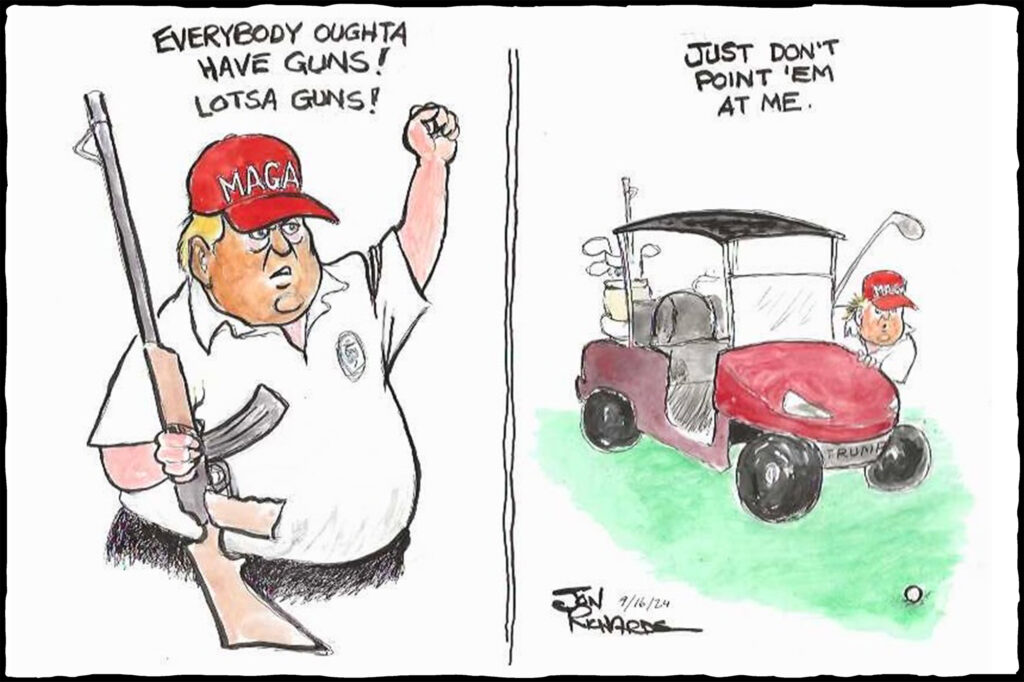The alleged second Trump assasination attempter, Ryan Routh, appears to be a vocational flake. Multiple news organizations have checked him out. He has no affiliations with any political activist group, left or right. He was a Trump supporter in 2016 but changed his mind at some point.
He did spend time in Ukraine, where he claimed to be recruiting foreign soldiers to fight against the Russian invasion. He also claimed to have somehow obtained a lot of drones for the cause. But it appears he mostly just hung out near the Kyiv hotel where most of the journalists stayed and occasionally got himself interviewed. The Ukrainians made him out to be a crank with several loose screws and wouldn’t work with him. In truth he recruited nobody and apparently obtained nothing.
What’s more interesting to me is this story in Public Notice by Lisa Needham. Although by all appearances Routh intended to shoot someone on the golf course — presumably Donald Trump — all he’s been charged with are weapons charges. And it’s probably the case that’s about all the law can hang on him. And even that is mostly because he has a prior felony conviction and is not supposed to possess firearms. If he’d been a genuine “law-abiding citizen,” he’d be down to one count, of possessing a firearm with a scraped-off serial number.
Under Gov. Ron DeSantis, Florida got rid of even the most meager safety requirements, such as requiring a permit or undergoing training and a background check. Sure, it’s still against the law for a person with a felony conviction to have a gun, but what guardrails are left to stop him from getting one or two or a dozen?
None of this is stopping DeSantis from demanding that Florida take the investigation away from the federal government, not just because he’s sure the Deep State will bury the truth or whatever, but also so that Routh could be charged under state law with attempted murder and potentially serve life in prison. Good luck, buddy. Routh didn’t get a shot off and was roughly 300-500 yards from Trump when he was spotted. He wasn’t even trespassing, as he was on the public side of the golf course fence.
To get to life in prison, Florida would have to charge Routh with attempted first-degree felony murder and prove that he was attempting to kill Trump in the course of committing a different underlying crime like arson, burglary, or carjacking. DeSantis thinks he’ll get there by exploring “red flags” about Routh’s “associations, his motivations, and his ideology,” but even if Routh was a card-carrying Marxist who had been volunteering for the Harris campaign for months, it doesn’t make his behavior attempted murder.
Regarding the scraped-off serial number, Needham points out that “In 2022, a federal judge in West Virginia concluded that since there were no serial numbers at the time of the Founding Fathers, it’s unconstitutional to ban people from obliterating serial numbers or possessing a gun with an obliterated serial number.” That decision was reversed, but with dissents. One of the dissenters was a Trump appointee.
And this is what happens when gun laws are written by a crazy gun-worshiping cult. If Routh made no declarations that he intended to kill Trump that day, he could argue in court he was just on the lookout for alligators, or something. As far as Routh’s “red flags” are concerned, they seem to say that like Trump himself, Routh is mentally miswired and obsessed with seeking glory. According to several news stories he was smiling and laughing during his arraignment, and why not? He was finally getting what he wanted — attention.
And I’m certainly not saying the law should let Routh go. He’s not a stable person. If it could be guaranteed he wouldn’t have access to guns he might be harmless enough, but this is America. Anyone can always get a firearm, somehow. But he’s probably not psychotic, just flakey. So I’m not sure he could be committed to a mental hospital under present law. I don’t know what anyone’s going to do with him.
Routh sounds a bit like Charles J. Guiteau, who assassinated President James Garfield in 1881. Guiteau was an obscure man who had supported Garfield in the 1880 election. He published and distributed a badly written essay about Garfield to help him get elected, and then when Garfield won Guiteau became obsessed with the belief that Garfield owed him. He spent some time loitering near the White House, accosting State Department officials on the streets, demanding to be assigned to the consul in Vienna or Paris. And eventually he got tired of waiting and decided God wanted him to shoot Garfield, and he did. Flakes with guns can be dangerous.





